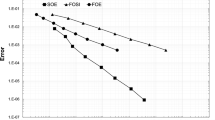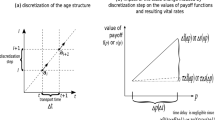Abstract
Numerical methods are presented for a general age-structured population model with demographic rates depending on age and the total population size. The accuracy of these methods is established by solving problems for which alternate solution techniques are available and are used for comparison. The methods reliably solve test problems with a variety of dynamic behavior. Simulations of a blowfly population exhibit cyclic fluctuations, whereas a simulated squirrel population reaches a stable age distribution and stable equilibrium population size. Life-history attributes are easily studied from the computed solutions, and are discussed for these examples. Recovery of a stressed population back to equilibrium is examined by computing the transition in age structure, and the transient behavior of other properties of the population such as the per capita growth rate, the average age, and the generation length.
Similar content being viewed by others
References
Barkalow, F. S., Jr., Hamilton, R. B., Soots, R. F.: The vital statistics of an unexploited gray squirrel population. J. Wildl. Manage. 34, 489–500 (1970)
Charlesworth, B.: Evolution in age-structured populations. Cambridge: Cambridge University Press 1980
Goudriaan, J.: Boxcartrain methods for modelling of ageing, development, delays and dispersion. In: Metz, J. A. J., Dickmann, O. (eds.) The dynamics of physiologically structured populations, pp. 453–473. Berlin Heidelberg New York: Springer 1986
Gurney, W. S. C., Blythe, S. P., Nisbet, R. M.: Nicholson's blowflies revisited. Nature 287, 17–21 (1980)
Gurney, W. S. C., Nisbet, R. M., Lawton, J. H.: The systematic formulation of tractable single-species models incorporating age structure. J. Anim. Ecol. 52, 479–495 (1983)
Gurtin, M. E., MacCamy, R. C.: Non-linear age-dependent population dynamics. Arch. Ration. Mech. Anal. 54, 281–300 (1974)
Harten, A., Osher, S.: Uniformly high order accurate non-oscillatory schemes. I. SIAM J. Numer. Anal. 24, 279 (1987)
Hyman, J. M., Stanley, E. A.: Using mathematical models to understand the AIDS epidemic. Math. Biosci. 90, 415–473 (1988a)
Hyman, J. M., Stanley, E. A.: The effect of social mixing patterns on the spread of AIDS. In: Castillo-Chavez, C. et al. (eds.) Mathematical approaches to problems in resource management and epidemiology. (Lect. Notes Biomath., vol. 81, pp. 190–219) Berlin Heidelberg New York: Springer 1988b
Lax, P. D., Wendroff, B.: Systems of conservation laws. Commun. Pure Appl. Math. 13, 217–237 (1960)
May, R. M.: Stability and complexity of model ecosystems. Princeton: Princeton University Press 1975
Metz, J. A. J., Diekmann, O. (eds.): The dynamics of physiologically structured populations. Berlin Heidelberg New York: Springer 1986
McKendrick, A. G.: Applications of mathematics to medical problems. Proc. Edin. Math. Soc. 44, 98–130 (1926)
Nicholson, A. J.: Compensatory reactions of populations to stresses, and their evolutionary significance. Aust. J. Zool. 2, 1–8 (1954a)
Nicholson, A. J.: An outline of the dynamics of animal populations. Aust. J. Zool. 2, 9–65 (1954b)
Nicholson, A. J.: The self-adjustment of populations to change. Cold Spring Harbor Symp. Quant. Biol. 22, 153–173 (1957)
Nisbet, R. M., Gurney, W. S. C.: Modelling fluctuating populations. New York: Wiley 1982
Osher, S., Sweby, P. K.: Recent developments in the numerical solution of non-linear conservation laws. In: Iserles, A., Powell, M. J. D. (eds.) State of the art in numerical methods. (IMA Conf. Ser., vol. 9, pp. 681–700) Oxford: Clarendon Press 1987
Richtmyer, R. D., Morton, K. W.: Difference methods for initial-value problems. New York: Wiley 1967
Sharpe, F. R., Lotka, A. J.: A problem in age distribution. Philos. Mag. 21, 435–438 (1911)
Sod, G. A.: Numerical methods in fluid dynamics. Cambridge: Cambridge University Press 1985
Smith, N. B.: Some aspects of reproduction in female gray squirrels Sciurus c. carolinensis Gmelin, in Wake County, North Carolina. M. S. Thesis, North Carolina State University, Raleigh (1967)
Strikwerda J. C.: Finite difference schemes and partial differential equations. Belmont, CA: Wadsworth & Brooks/Cole 1989
Sulsky, D. L., Vance, R. R., Newman, W. I.: Time delays in age structured populations. J. Theor. Biol. 141, 403–422 (1989)
Vance, R. R., Newman, W. I., Sulsky, D. L.: The demographic meanings of the classical population growth models in ecology. J. Theor. Ecol. 33, 199–225 (1988)
von Foerster, H.: Some remarks on changing populations. In: Stohlman, F. Jr. (ed.) The kinetics of cellular proliferation, pp. 382–407. New York: Grune & Stratton 1959
Webb, G. F.: Theory of nonlinear age-dependent population dynamics. New York: Dekker 1985
Author information
Authors and Affiliations
Rights and permissions
About this article
Cite this article
Sulsky, D. Numerical solution of structured population models. J. Math. Biol. 31, 817–839 (1993). https://doi.org/10.1007/BF00168048
Received:
Revised:
Issue Date:
DOI: https://doi.org/10.1007/BF00168048




